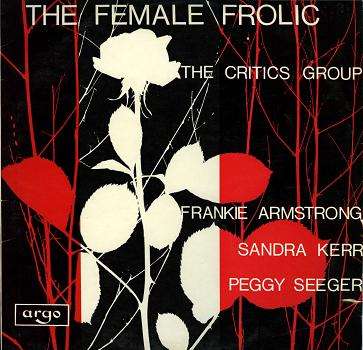
From the sleeve notes:
"A woman is an angel at ten, a saint at twenty,
A devil at forty and a witch at fourscore.
(traditional proverb).
There can be no doubt that the above saying was coined by a man, and most men would cheerfully agree with it, without thinking that with a little re-writing it could apply equally well to themselves. The battle of the sexes has been raging throughout human history and shows no signs of stopping in the foreseeable future. Indeed, life would be very dull if it did. In individual skirmishes, honours are probably more or less equally shared between the two sides, but on the larger social scale, men have usually succeeded in keeping women in a state of subjugation, despite gallant forays mounted by shock-troops as various as the Suffragettes and Lysistrata and . her determined band of Athenian beauties. How long men can continue to maintain their supremacy is a matter for conjecture.
Great writers from the time of Aristophanes to the present day have drawn inspiration from the sometimes tragic, sometimes hilarious incidents of this battle and so also have the innumerable and mostly un-named poets of the folk tradition. It is with the attempts of this latter group to delineate some of the many aspects of woman's life that this record is concerned.
In the late 1950's. the British folk song revival grew out of the craze for American skiffle and, at first, singers tended to base their repertoires on the folk-songs and blues of North America. However, in searching for the origins of Appalachian music, they turned their eyes back across the Atlantic and rediscovered the ballads and songs of their own islands. The singers of the British folksong revival, who originally thought their native music dowdy and unexciting, were astonished to find a rich treasury of song waiting to be explored. Men and women alike chose their repertoires with little consideration towards their sex. For example, it was not uncommon to hear pretty and solemn young girls performing songs from the abouring industries such, as mining, or singing tough and lusty sea shanties in voices that would have been reduced to inaudibility by the gentlest of Atlantic zephyrs: It would have appeared from a folk club programme that men were predominant amongst traditional singers.
This certainly was not so for singers in the oral tradition. Many of the finest traditional performers have been women and in many instances it has been the sole responsibility of the female to carry the songs and traditional style of singing to the next generation. This is especially true of our nomadic people, the gypsies and tinkers, for it is their women who carried some of the great song masterpieces into our time. A few that spring to mind are Jessie Murray of Frazerborough, the Stewarts of Blairgowrie and Queen Caroline Hughes, a travelling woman with a great fund of traditional songs and a brilliant singing style who was recorded for the first time outside Poole, Dorset in 1964. Cecil Sharpe, who collected songs in the early years of this century, found that a great number of his informants were women, one of the finest being Mrs. Overd of Langport in Somerset, who gave him over 200 songs. Sharpe said of her "Probably every generation has produced a small percentage of singers like Mrs. Overd and to her special gifts must be attributed many of those musical qualities which are the glory of folksong". Writing songs also is a field which women have not left untouched; the 1930's produced a proliferation of female song-writers in the U.S.A., Fanny Sellins, Sarah Ogan and Aunt Molly Jackson among them.
Frankie Armstrong, Sandra Kerr and Peggy Seeger are all members of the Critics Group, which meets regularly to discuss and explore the art of folksong and how best these arts can be applied in the revival. They felt that there was a need for a record to trace the Woman's constantly changing position in terms of traditional folksong and to try and open up the large and varied repertoire available to the female revival singer."
Tracklist: Side 1:
1. The Doffin' Mistress (Irish)
2. Girl of Constant Sorrow (American)
3. The Blacksmith (English)
4. My Husband's Got No Courage in Him (English)
5. The Generous Lover (Irish)
6. The Whore's Lament (American)
7. Geordie (English)
8. Come Me Little Son (Contemporary English)
Side 2:
9. The Female Frolic (English)
10. Children's Sequences (English / Scottish / American)
11. An Old Man Came Courting Me (Canadian)
12. Miner's Wife (Contemporary English)
13. The Factory Girl (Irish)
14. Lowell Factory Girl (American)
15. The Broomfield Hill (English)
16. The Housewife's Lament (American)
Critics Group - The Female Frolic (1968)
(256 kbps, cover art included)
2 Kommentare:
Dear Sir...
Have wanted for sometime to specify a good many of the important historical titles you have posted on your fine site as missing links and kindly ask if they may be all be restored. Would like to start a list beginning with 'The Female Frolic'.
Blessings...
Step by step the requested links will be re-upped. All the best!
Kommentar veröffentlichen